It’s okay, you can go in there, he said, with profuse nodding and smiling, unlocking the gated enclosure and gesturing for me to enter. His rake in one hand, a crisp blue shirt tucked neatly into the fawn gabardine of the retired salaryman, narrow-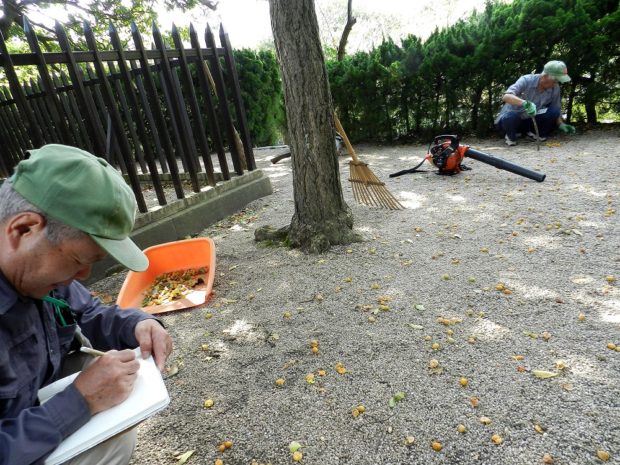 brimmed cotton hat and gardening gloves impeccable despite the pile of leaves he and his buddy had amassed. ‘Kaba Kuneguchi’, he would write in my notebook, ‘September 30th, Heisei 23’ (2011), in hiragana to make it easy for the gaijin. I’d been circling the Miura Anjin memorial for ten minutes taking photos from outside the tall iron fence. Kaba was a volunteer with the Tsukuyama Park Preservation Society. Officialdom. It was okay.
brimmed cotton hat and gardening gloves impeccable despite the pile of leaves he and his buddy had amassed. ‘Kaba Kuneguchi’, he would write in my notebook, ‘September 30th, Heisei 23’ (2011), in hiragana to make it easy for the gaijin. I’d been circling the Miura Anjin memorial for ten minutes taking photos from outside the tall iron fence. Kaba was a volunteer with the Tsukuyama Park Preservation Society. Officialdom. It was okay.
I grew up in an Australia ambivalent toward the Japanese. Our grandparents had faced them in conflagration. In the 70s, when the dominance of local, British and American manufactures was overwhelmed by more available goods from Japan, ‘Jap crap’ entered the vernacular, referring to anything cheap or lacking quality. If I’d had an amoebic concept of the Japanese as a kid, that was all I knew.
Somewhere in my mid-teens, amid my awakening social and political consciousness, two things happened which ended any ambivalence I might have absorbed. Firstly, my grandfather opened-up about his wartime experiences, and I learned that despite the lingering fallout of wartime propaganda and its effect on some Australians, the attitudes of the old warriors themselves could be far from negative. They’d seen the suffering of Japanese alongside their own. They’d seen evil committed by all sides. What they’d fought for and won was peace, not lasting, purposeless hatred.
 Around that time, I read Trevanian’s Shibumi, a broad, brooding novel. Shibumi revealed to a fifteen-year-old that there are alternative frames through which to look at the world, and that all knowledge is refracted by the conduits through which it’s conveyed. The novel also introduced me to the excitement of the political thriller. Protagonist Nicolai Hel was born in Shanghai to an exiled White-Russian mother, and raised in Japan by a surrogate father, General Kishikawa of the Imperial Japanese Army. It’s this upbringing, with an acute sensitivity to custom, honour, the aesthetic, and clean, lethal violence, that would equip Nicolai for a career as an international assassin.
Around that time, I read Trevanian’s Shibumi, a broad, brooding novel. Shibumi revealed to a fifteen-year-old that there are alternative frames through which to look at the world, and that all knowledge is refracted by the conduits through which it’s conveyed. The novel also introduced me to the excitement of the political thriller. Protagonist Nicolai Hel was born in Shanghai to an exiled White-Russian mother, and raised in Japan by a surrogate father, General Kishikawa of the Imperial Japanese Army. It’s this upbringing, with an acute sensitivity to custom, honour, the aesthetic, and clean, lethal violence, that would equip Nicolai for a career as an international assassin.
A few years later I saw rallies protesting Japanese investment in real estate draw 1500 people on the Gold Coast, while The Canberra Times reported that Japanese were fourth on the ranking of foreign investors in Australian real estate, behind the UK, the US and New Zealand.
Then in the early 90s a Japanese girl approached me at university and asked for directions, and my hereto vague awareness of Japan became a love affair with Japan.
The gate was open, and I walked through.
*
Shibumi was the first of many novels written by Westerners about the Japanese that I’ve relished. As I write, within eyesight are both Shibumi and its sequel, Satori, a homage to Trevanian authored by Don Winslow. There’s The 47 Ronin Story by John Allyn, Tokyo Year Zero by David Peace, Rendezvous at Kamakura Inn by Marshall Browne, and Shogun by James Clavell. Liza Dalby’s The Tale of Murasaki is missing from my bookshelf, borrowed by some book-louse without the class to return it.
Shibumi aside, I don’t think any of these have been pronounced works of literary genius. There are famed Japanese authors on my bookshelf, both in Japanese (property of my spouse, Chizuru) and in translation. However, it’s this type of Westerners’ imaginary Japan more than Japan’s own literature that hooks me. It’s a guilty pleasure, because somewhere in my schooling are Edward Said’s Orientalism, and Alison Broinowski’s The Yellow Lady: Australian Impressions of Asia. My cherished novels exoticise, romanticise and distort the Japanese in some of the ways my liberal education would disparage. Worse still, I detect orientalist traits in my personal life, which can muddle things in a fifty per cent Japanese household.
Some of these novels are based on historical people, and in 2011, during a visit to the in-laws, I took an excursion with my new camera to locate them.
I’d been enraptured by Liza Dalby’s The Tale of Murasaki. Murasaki Shikibu, who lived a thousand years ago, is remembered for authoring The Tale of Genji, often  credited as the world’s first novel, and for her poetry and her diaries which provide a
credited as the world’s first novel, and for her poetry and her diaries which provide a
titillating exposé of Heian era court culture. James Clavell’s Shogun was also fresh in my memory. I was inspired to read it after catching a re-run of the TV miniseries. Shogun is based on the life of Englishman, William Adams, known to the Japanese as Miura Anjin, who settled in Japan four hundred years ago.
I set forth to see what traces I could find of these two characters in 2011.
* *
Yokosuka, 30 September 2011
Having wandered into Tsukuyama Park in the city of Yokosuka at the southern end of Tokyo bay, I was drawn to a broad granite staircase that, from the bottom, gave no clue about where it led, only that such an imposing set of stairs had to be going somewhere important. Approaching the top, directly ahead two cenotaphs on a dais rose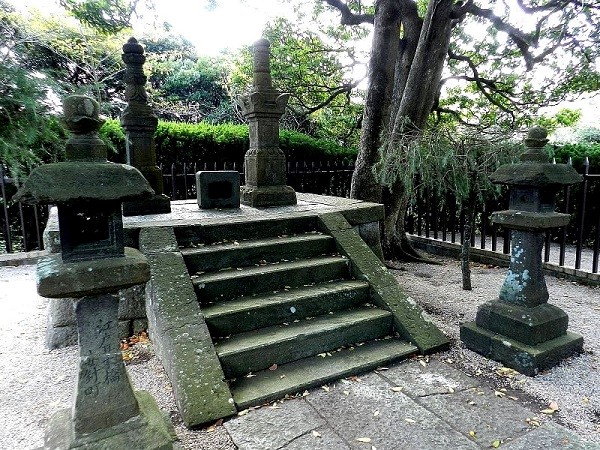 into view, abstract forms in stone and yet full of humanity. One, with fluid edges and floral suggestions, was unmistakably feminine, the other, sharper edged with less organic accents, discernibly male. Here stood a man and woman in timeless consort. Side by side and full of vigour, the immigrant samurai and lady of Hemi overlooked their fief, and beyond it in the distance the metropolis once known as Edo. I’d stumbled across the mossy cenotaphs of Miura Anjin (William Adams) and Magome Oyuki. My guide map was in Japanese so I’d somehow not anticipated them, though I’d been following Adams’s trail. I wasn’t sure what I was looking for when I’d set out to find what I could of William Adams, but I knew this was it. Like Adams, and James Clavell’s John Blackthorne, I’d fallen in love with a Japanese. Like Adams and Blackthorne I’d fallen in love with the Japanese. In form and placement these
into view, abstract forms in stone and yet full of humanity. One, with fluid edges and floral suggestions, was unmistakably feminine, the other, sharper edged with less organic accents, discernibly male. Here stood a man and woman in timeless consort. Side by side and full of vigour, the immigrant samurai and lady of Hemi overlooked their fief, and beyond it in the distance the metropolis once known as Edo. I’d stumbled across the mossy cenotaphs of Miura Anjin (William Adams) and Magome Oyuki. My guide map was in Japanese so I’d somehow not anticipated them, though I’d been following Adams’s trail. I wasn’t sure what I was looking for when I’d set out to find what I could of William Adams, but I knew this was it. Like Adams, and James Clavell’s John Blackthorne, I’d fallen in love with a Japanese. Like Adams and Blackthorne I’d fallen in love with the Japanese. In form and placement these 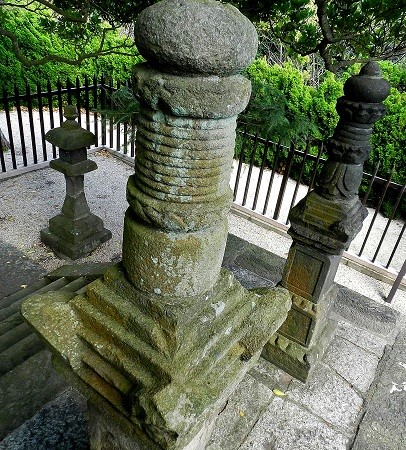 cenotaphs eloquently captured Adams and
cenotaphs eloquently captured Adams and
Oyuki in memorial, while in aspiration they captured me.
Four hundred years ago, favoured by shogun Tokugawa Ieyasu, Adams was elevated from stranded foreign sailor to Japan’s highest nobility. Forced to leave his life in England behind, including a wife, he’d remarried to Oyuki, a woman of modest social status, out of love.
In James Clavell’s novel based on Adams’s life, protagonist Blackthorne falls for married noblewoman, Mariko, whose reciprocation would’ve resulted in both their deaths. Eventually resolved to be together, Mariko dies during the novel’s version of the Battle of Osaka, an event at which the real Adams was present.
Mariko’s passing in Shogun is a dramatic climax that tortures the reader with ‘what ifs’. ‘No, this can’t be happening,’ you’re thinking, as you will the character back to life, at the same time delighting in the tragedy of it.
Alison Broinowski points out though, that this is a common trope in Western imaginative discourse on the orient. She calls it the ‘Butterfly Phenomenon’, after Puccini’s tragic heroine.
An Eastern woman may be delightful, but she cannot become a Western wife, and her child is a half-breed. After her day in the sun with her lover, Cho cho san will pay the price of pleasure: her wings will fade, and she will perish. She is a fragile art object, but also a cheap, replaceable commodity.
Broinowski
Privately, I must confess to… let’s just say a slight moistening of the eye as Blackthorne’s Mariko receded on her funeral pyre, farewelled in her white kimono, like Chizuru wore on our wedding day.
Despite the outcome for Clavell’s Mariko and Puccini’s Cho-cho san, in the case of the real life Oyuki Magome, there was no reunion with the Western woman. Adams chose life with Oyuki.
Sunpu Castle, Shizuoka, 1 October 2011.
Tokugawa Ieyasu is as revered by the Japanese as a statesman can be. In the West, his profile would approximate a Julius Caesar. He’s the figure who provided the title for Clavell’s novel, ‘shogun’ being the name given to a hereditary military dictatorship which, when secured by Tokugawa in battle in 1600, signalled the beginning of Japan’s Edo Era.
Adams sometimes came to visit 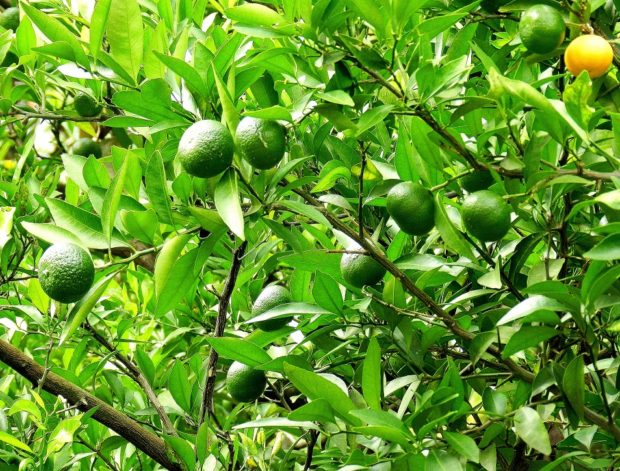 his benefactor, Tokugawa, in his retirement at Sunpu. Within Sunpu Castle Park survives a sprawling mandarin tree, planted by Ieyasu, that it’s easy to imagine could have borne fruit that Adams tasted.
his benefactor, Tokugawa, in his retirement at Sunpu. Within Sunpu Castle Park survives a sprawling mandarin tree, planted by Ieyasu, that it’s easy to imagine could have borne fruit that Adams tasted.
The castle’s been restored to its Tokugawa specifications, and there are displays of military artefacts and tactics of the day. In Clavell’s novel, Ieyasu’s avatar, ‘Lord Toranaga’, represents the pinnacle of the samurai class. The samurai, and concepts like bushido, ‘harakiri’, ninja, the katana (Japanese 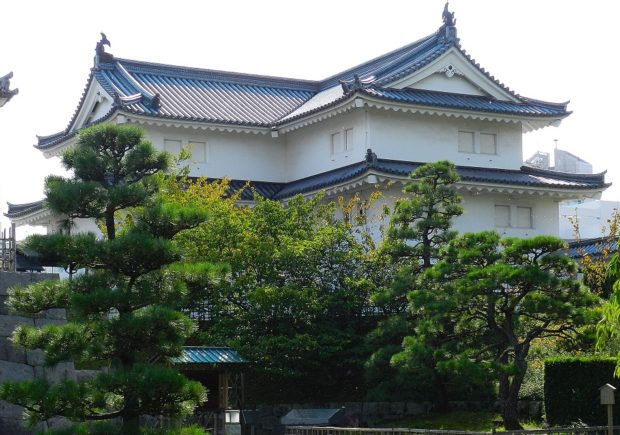 sword) and its vicious application, are preoccupations in Western imagery of Japan. They coincide with the orientalist notion of the savage, inscrutable, deadly ‘other’. Some Japanese will chuckle at this Western preoccupation, and it marks one as a ‘hen-na-gaijin’ (silly foreigner). I must keep my curiosity about these things in the closet.
sword) and its vicious application, are preoccupations in Western imagery of Japan. They coincide with the orientalist notion of the savage, inscrutable, deadly ‘other’. Some Japanese will chuckle at this Western preoccupation, and it marks one as a ‘hen-na-gaijin’ (silly foreigner). I must keep my curiosity about these things in the closet.
All the same, I can’t help having some fun with our imaginary Japanese traits. My son Bryce and I are co-conspirators. When Chizuru’s cross with one of us, we might whisper to each other in mock horror, “They chop people’s heads off”. I told my dad 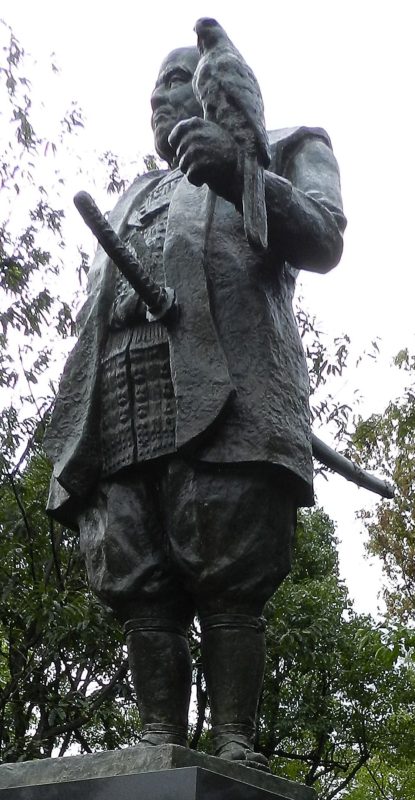 once, who was being a rogue, “She won’t say anything. She’ll just hand you the wakizashi,” (the short sword with which one performs seppuku).
once, who was being a rogue, “She won’t say anything. She’ll just hand you the wakizashi,” (the short sword with which one performs seppuku).
Do we sometimes fail to differentiate the historical other when it comes to another’s
culture? There are plenty of Japanese who themselves like cultivating this aspect of their history. Are we simply sharing that veneration? Does it mirror a romanticisation with our historical selves? Adams’s contemporaries in the West included William Shakespeare, Miguel Cervantes, and fellow adventurer, Captain John Smith, who co-habited with the natives at Jamestown, the first English settlement in America, at the same moment as Adams in Japan.
Ito, Izu Peninsula, 1 October 2011.
I made it to Ito on dusk, where Tokugawa put Adams to work building a European style ship. Deep in the Izu peninsula, Ito was away from the prying eyes of Tokugawa’s enemies. Though Adams had studied shipbuilding, he’d never actually done it. He was a pilot and navigator. Fortunately for Adams, among the survivors of the Liefde, the ship 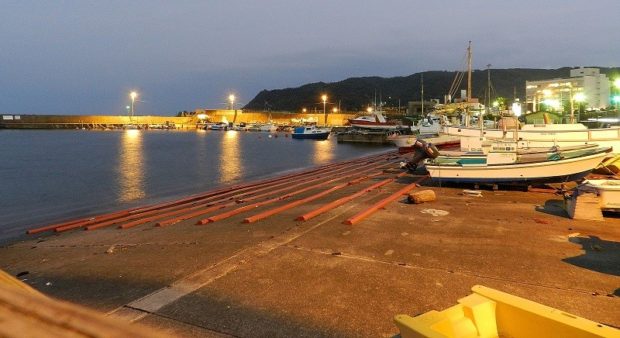 on which they’d drifted wretchedly into Japanese waters, was Pieter Janszoon, her shipwright. In Shogun, Lord Toranaga has Blackthorne’s successfully constructed first ship destroyed, breaking his hopes of sailing home to England. Another trope: the wily, manipulative oriental.
on which they’d drifted wretchedly into Japanese waters, was Pieter Janszoon, her shipwright. In Shogun, Lord Toranaga has Blackthorne’s successfully constructed first ship destroyed, breaking his hopes of sailing home to England. Another trope: the wily, manipulative oriental.
Standing here in twilight in October 2011 looking toward the headlands at either end of the bay, with its distinctive rocky outcrop off to the southeast, I knew that despite the concrete, cars, and electric lights, Adams would probably recognise this place
today. The thought brought him that much closer to me. When he produced his first ship here in 1604, Japan was on the cusp of a new epoch, and Adams was part of its foundation.
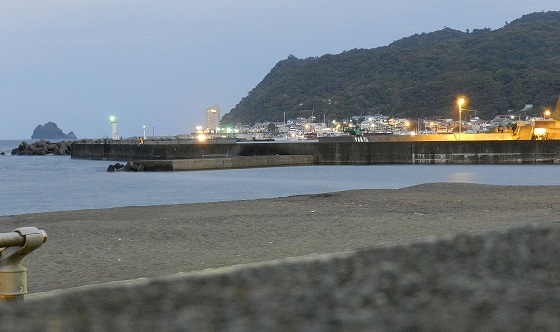
The harbour of Ito on the Izu Peninsula, where William Adams shared his knowledge of European shipbuilding with Tokugawa Ieyasu.
Otsu, 2 October, 2011.
In Liza Dalby’s novel, it’s from the southern shore of Lake Biwa that Murasaki Shikibu embarks with her father for his posting as Governor of Echizen. She’s of 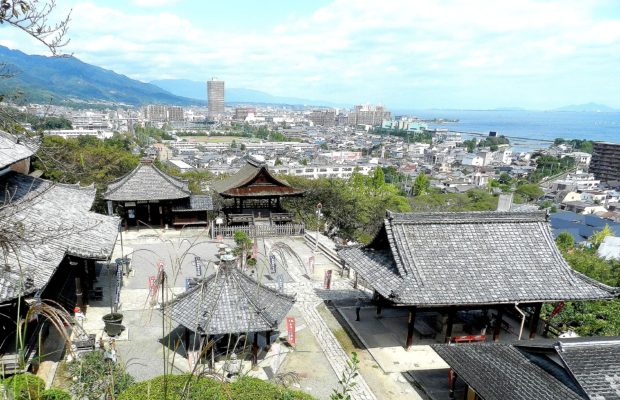 marriageable age and should be staying behind in the society of the capital, but she’s adventurous. She’s cultured in Chinese writing and its venerated forms of poetry, and she can go toe-to-toe with anyone in its customary use as word-sport. In her novel, Dalby explores this in her portrayal of a historical visit by a Chinese delegation to Echizen.
marriageable age and should be staying behind in the society of the capital, but she’s adventurous. She’s cultured in Chinese writing and its venerated forms of poetry, and she can go toe-to-toe with anyone in its customary use as word-sport. In her novel, Dalby explores this in her portrayal of a historical visit by a Chinese delegation to Echizen.
I stand on the pier at Otsu’s ferry station looking over the lake, imagining their boat out amid the water craft approaching the distant shore.
Legend has it that Murasaki conceived of The Tale of Genji at Ishiyama-dera temple in Otsu, where she’d come in retreat. I wonder if it was after the early death of her husband, or during her pregnancy before their daughter’s birth. In later life she returned to Ishiyama-dera in retirement to devote herself to writing and religion. At the temple, they maintain at least one Buddhist scroll in her handwriting.
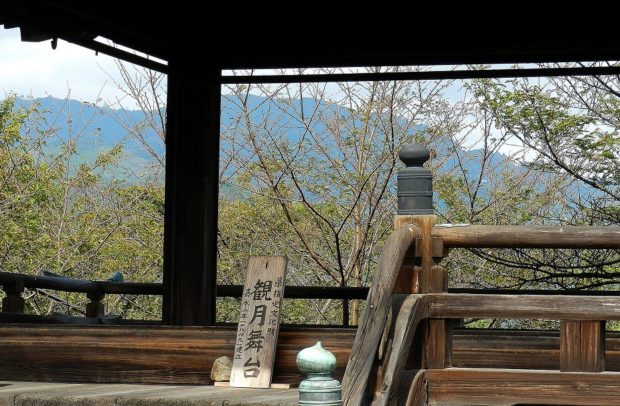
I’d bought some textured washi paper and a writing brush at the Oji Paper Museum, but I’d left them in Tokyo. I made do with the least ordinary paper I could find in a nearby convenience store, and like Genji, wrote a poetic thank you note for my hotel receptionist, Ms Ito. The note remains among the papers I brought back from that trip, undelivered.
Kyoto, 4 October 2011.
The family had caught up with me, and Bryce was pestering me to take him to the Gokouyu onsen, which was apparently something special. Eleven at the time, Bryce loved the Japanese bath-house. I got dragged along.
The onsen was extensive, and Bryce’s enthusiasm for the steamy cleansing atmosphere was infectious. We scrubbed, rinsed, and when I went to dip into one of the baths, a dad jumped up startled, grabbing his two kids by the arms in hasty escape. Oh dear, is this some sort of ‘hairy gaijin’ thing?
Bryce and I bobbed around the inexplicable variety of hot, cold, warm, and cool baths.
“Hey Otto-san, come and try this one,” he squeaked in excitement. He badgered me over and watched with a grin as I dipped into the bath.
What
What tha’
Was that?
I’d experienced this once before in the shower at the Tamworth football grounds, where there was an electrical wiring problem in the visitors’ sheds. “Ow!” My shock was “Ow,” apparently very “Ow” amusing to Bryce. What sort of sadist made a bath that gave measured electric jolts, and why would anyone get in it?
This was not like John Blackthorne’s bath in Shogun! The Sixteenth Century Englishman, Blackthorne had to be coerced into the bath. However, once he learned that the very pleasant Lady Mariko would join him, Blackthorne quickly realised the reinvigorating benefits of the onsen. Again, Broinowski frowns on this kind of ‘observation’ about the curious nuances of openness and modesty among Asiatic females.
Kyoto, 5 October 2011
Rozan-ji, in the garden of Murasaki Shikibu.
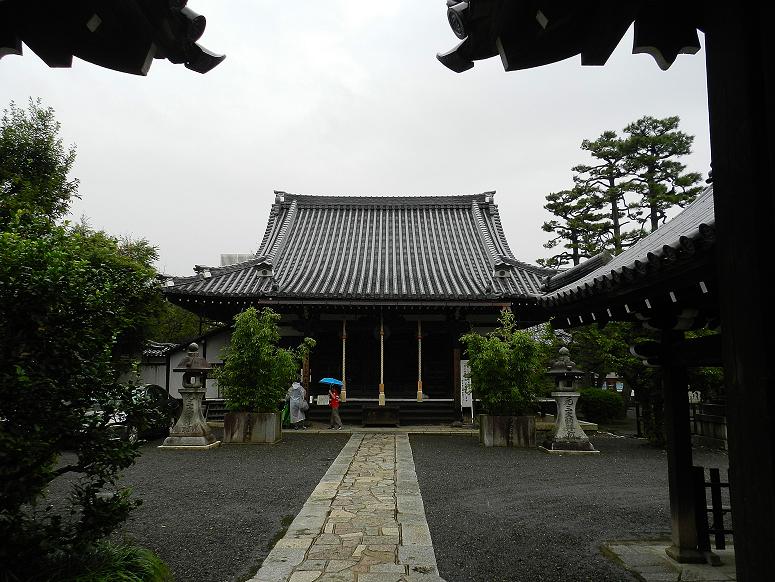 It’s most likely here a thousand years ago that Murasaki Shikibu wrote the first part of the Tale of Genji. It’s the site once occupied by the Tsutsumi-chunogon mansion, built by Murusaki’s great-grandfather, Fujiwara Kanesuke. Murasaki was born at Tsutsumi-chonogon and lived much of her life here. Her marriage in 998 was cut short by the death of her husband, Nobutaka, three years later. She moved from here to the court of the Heian imperial palace in about 1005 at the behest of regent, Fujiwara Michinaga, becoming lady-in-waiting to Empress Shoshi.
It’s most likely here a thousand years ago that Murasaki Shikibu wrote the first part of the Tale of Genji. It’s the site once occupied by the Tsutsumi-chunogon mansion, built by Murusaki’s great-grandfather, Fujiwara Kanesuke. Murasaki was born at Tsutsumi-chonogon and lived much of her life here. Her marriage in 998 was cut short by the death of her husband, Nobutaka, three years later. She moved from here to the court of the Heian imperial palace in about 1005 at the behest of regent, Fujiwara Michinaga, becoming lady-in-waiting to Empress Shoshi.
In her fictional account, The Tale of Murasaki, Liza Dalby depicts Michinaga having his way with Murasaki, without invitation and without protest.
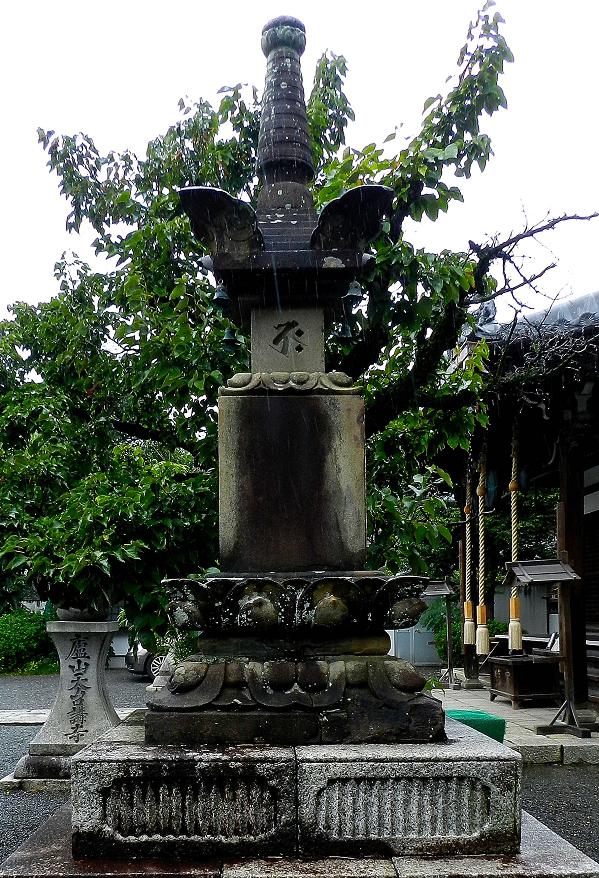
It’s not so much the rape that Broinowski might draw attention to, as the compliance of the oriental female in the Western imagination.
For the past 400 years Rozan-ji temple has occupied the site of Murasaki’s former home. 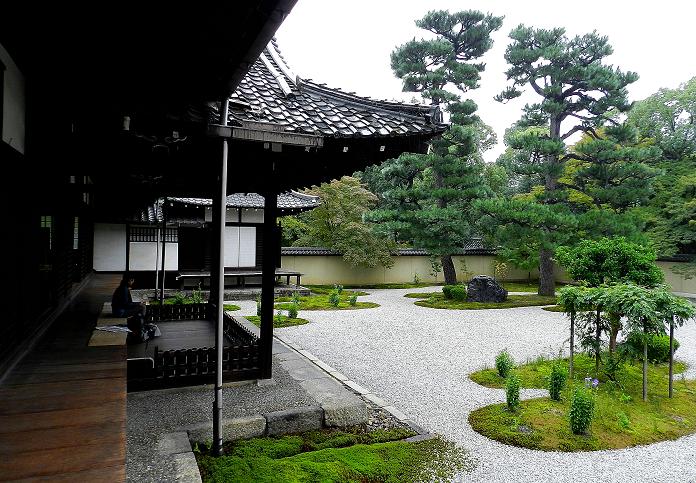 To sit and look over the Genji Garden, established in 1965, is to surrender your thoughts to a life lived on this spot a thousand years ago.
To sit and look over the Genji Garden, established in 1965, is to surrender your thoughts to a life lived on this spot a thousand years ago.
Yet, if spied, it’s the hidden inner garden of Rozan-ji, less grand, that inspires the imagination most. How long has this little stone bridge been here? Wouldn’t Lady Murasaki have trod that same path herself? In those years following her husband’s 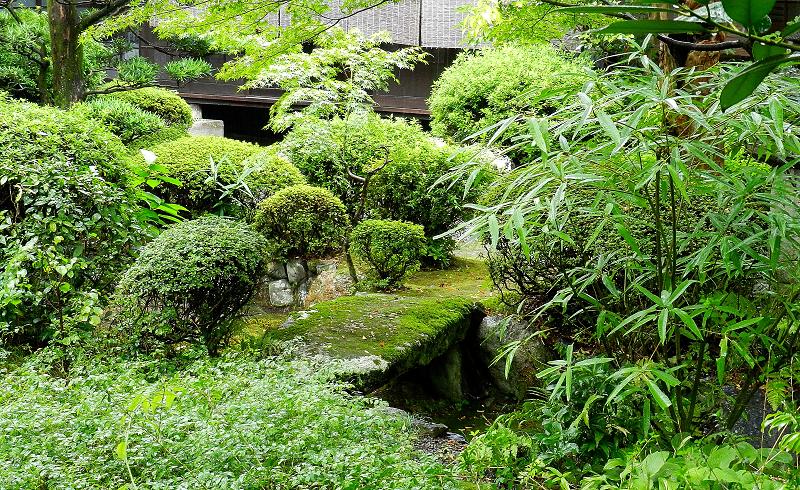 death, when she turned her energies cathartically to her Genji monogatari, would she not have put aside her writing brush sometimes and, eyes cast over this very garden in its seasons, have meditated on the transience of life and love? In this earth are there not still traces of her incense, on the wind not faint reverberation of her poems?
death, when she turned her energies cathartically to her Genji monogatari, would she not have put aside her writing brush sometimes and, eyes cast over this very garden in its seasons, have meditated on the transience of life and love? In this earth are there not still traces of her incense, on the wind not faint reverberation of her poems?
The Sepulchre of 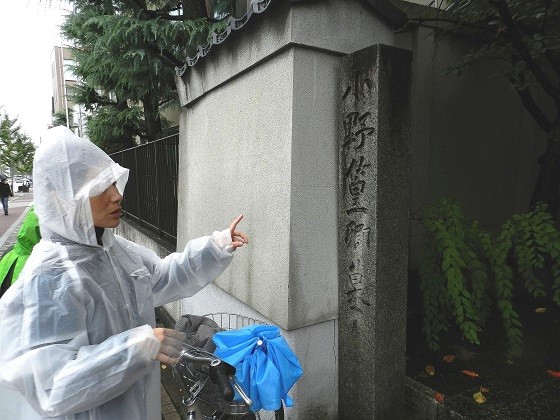 Lady Murasaki
Lady Murasaki
We’d cycled in the rain through Kyoto streets, our destination the final resting place of Murasaki Shikibu. “It’s around here on the map,” I said.
I think we rode past it and turned back.
“Oh, hang on, it’s here.”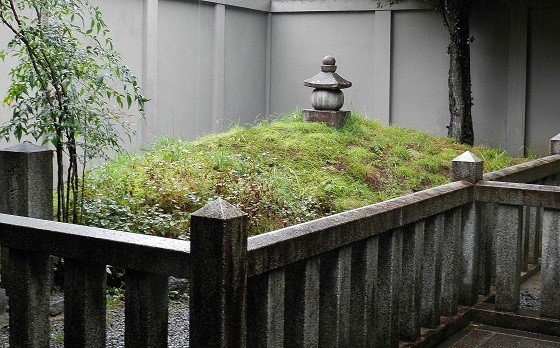
Down an unassuming footpath off Horikawa-dori, a kilometre north of where the
Heian era imperial palace had stood, I’d come into the physical presence of my heroine. Was it her bodaciousness in doing other than expected from a woman of her era; learning, marrying at a time of her 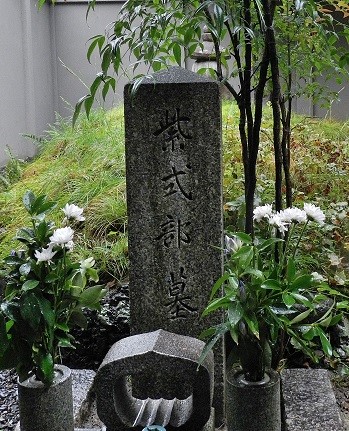 choosing? Taken by her stories of lustful encounters, and the underlying loneliness and yearning in her own story, I was enamoured with a woman who’d been dead a thousand years. Was she an orientalist ideal I sought in my Japanese wife? Am I another Westerner romanticising the exotic, unable to distinguish the temporal other?
choosing? Taken by her stories of lustful encounters, and the underlying loneliness and yearning in her own story, I was enamoured with a woman who’d been dead a thousand years. Was she an orientalist ideal I sought in my Japanese wife? Am I another Westerner romanticising the exotic, unable to distinguish the temporal other?
There I was looking at a sepulchre on a rainy day in Kyoto, scanning the surface of every rock carved in her honour, marvelling at the idea of being where Murasaki lay.
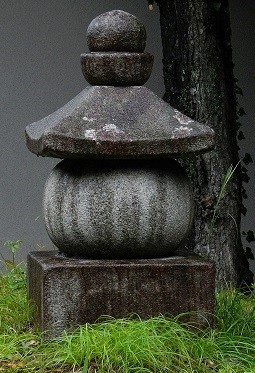
Biwa store, Kyoto 6 October 2011
The biwa is a mandolin-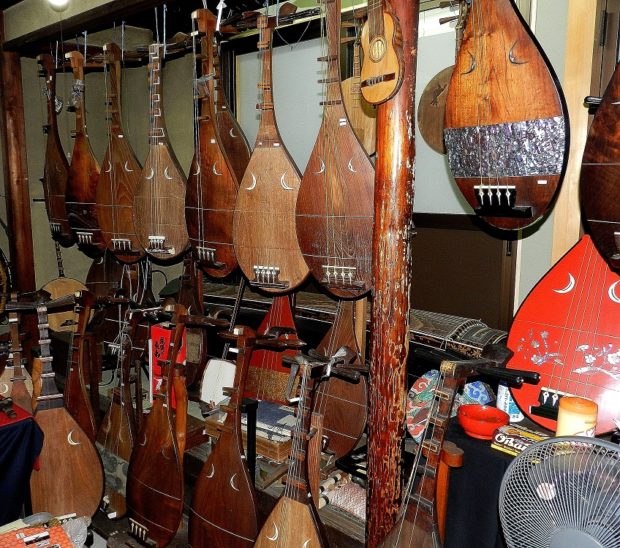 shaped stringed instrument, an instrument played by Murasaki’s protagonist, Genji, and Murasaki herself. On a suburban back-street we came across an antique store with battered biwa hanging from the walls and rafters in various states of disrepair. It’s the neighbourhood where, indelibly, I’d exchanged glances with a Maiko more than a dozen years before. Now that I think of it, it was during that visit to Japan that I met my wife, Chizuru.
shaped stringed instrument, an instrument played by Murasaki’s protagonist, Genji, and Murasaki herself. On a suburban back-street we came across an antique store with battered biwa hanging from the walls and rafters in various states of disrepair. It’s the neighbourhood where, indelibly, I’d exchanged glances with a Maiko more than a dozen years before. Now that I think of it, it was during that visit to Japan that I met my wife, Chizuru.
I linger in the store, trying to recall references to the Biwa in The Tale, like
It happened on a cool summer evening that Genji was sauntering round the Ummeiden in the palace yard. He heard the sound of a biwa proceeding from a veranda. It was played by this lady. She performed well upon it, for she was often accustomed to play it before the Emperor along with male musicians. It sounded very charming. She was also singing to it the “Melon grower.”
“Ah!” thought Genji, “the singing woman in Gakshoo, whom the poet spoke of, may have been like this one,” and he stood still and listened. Slowly he approached near the veranda, humming slowly, as he went, “Adzmaya,” which she soon noticed, and took up the song, “Do open and come in!”
Chizuru’s bored, and getting impatient. I look at her in dismay. Just when is this woman going to begin exchanging poetry with me? Perhaps if I build that tatami room she’ll rediscover her koto and play for me after our evening bath, until we end like Genji and his Fujitsubo.
* * *
Nihonbashi, Tokyo, 8 October 2011.
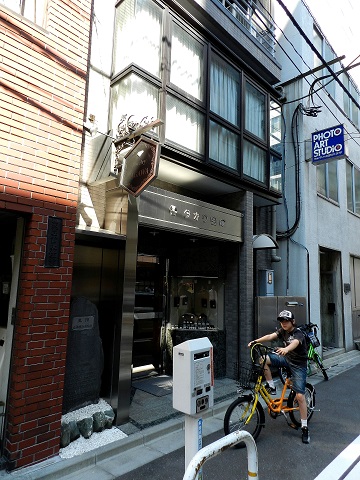 Bryce and I cycle down to the site of Miura Anjin’s mansion in Nihonbashi, where there’s a little stone memorial, well-tended. We head over to the imperial palace, and circle the giant statue of fourteenth century samurai,
Bryce and I cycle down to the site of Miura Anjin’s mansion in Nihonbashi, where there’s a little stone memorial, well-tended. We head over to the imperial palace, and circle the giant statue of fourteenth century samurai, 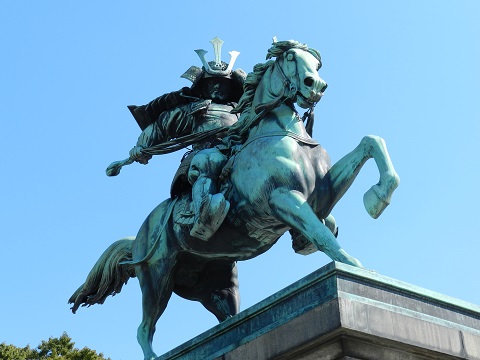 Kusunoki Masashige, on horseback. We pass an oversized motor-scooter with blue flake-metallic paint and chrome to excess. It’s a Harley Davidson parody, incurably Japanese, and its swept back styling oddly mirrors the stance of Masashige’s thundering steed.
Kusunoki Masashige, on horseback. We pass an oversized motor-scooter with blue flake-metallic paint and chrome to excess. It’s a Harley Davidson parody, incurably Japanese, and its swept back styling oddly mirrors the stance of Masashige’s thundering steed.
Unlike me, Bryce’s experience won’t be one of ‘encounter’ with another culture. The challenge will be owning, and being the custodian of two, dividing his energies between tending, like Kaba Kuneguchi at Tsukuyama Park, to both. He’ll become not merely the gatekeeper for two worlds, but the gate between them.
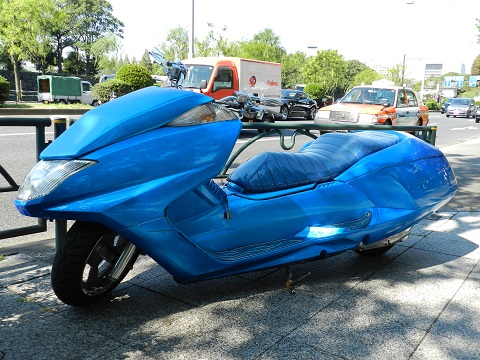
Photographs
More photos capturing the world of Murasaki Shikibu here.
More photos capturing the world of William Adams here.
References
Bowring, Richard and Shikibu, Murasaki. Murasaki Shikibu, Her Diary and Poetic Memoirs: a translation and study. Trans. Bowring, Richard. New Jersey: Princeton University Press, 1982.
Broinowski, Alison. The Yellow Lady: Australian Impressions of Asia, 2nd ed. Melbourne: Oxford University Press, 1996.
Clavell, James. Shogun, Hodder paperback edition. London: Hodder & Stoughton, 2006.
Dalby, Liza. The Tale of Murasaki, (Vintage edition). London: Vintage, 2011.
Naito, Satoko. “Genji monogatari and its reception.” In The Cambridge History of Japanese Literature, Shirane, Haruo and Suzuki, Tomi eds., pp. 193-204. Cambridge: Cambridge University Press, 2016. Downloaded Macquarie University Library 7 October 2016.
Nippon Steel Human Resources Development Company. Nippon, The Land And Its People, 3rd edition. Nippon Steel, 1988.
Shikibu, Murasaki. The Diary of Lady Murasaki (Penguin Classics), Kindle Edition. Trans. Bowring, Richard. London: Penguin, 1996.
Shikibu, Murasaki. The Tale of Gengi, Vols. 1 and 2. Trans. Seidensticker, Edward G. Tokyo: Tuttle, 1978.
Stewart, Andrew. “Survey highlights hatred of Japanese.” Canberra Times, Saturday 11 March 1989, page 9. Downloaded from TROVE, National Library of Australia, 6 November 2016.
Trevanian. Shibumi. London: Book Club Associates, 1980.
Wright, Tony. “Leather, Volvos and Japanese invaders.” Canberra Times, Thursday 9 June 1988, page 1. Downloaded from TROVE, National Library of Australia, 6 November 2016.
Yamamoto, Shoichi. William Adams and Yokosuka (pamphlet). Trans. McClure, Bonnie. Yokosuka: Yokosuka City, 2009.
Site Visits
Sepulchre of Murasaki Shikibu, Kyoto.
Ito, Izu Peninsula.
Lake Biwa, Otsu.
Nihonbashi, Tokyo.
Paper Museum, Oji.
Rozan-ji Temple, Kyoto.
Sumpu Castle, Shizuoka.
Tale of Genji Museum, Uji.
Tokyo National Museum, Ueno.
Tsukuyama Park, Yokosuka City.
Yokosuka City Museum, Yokosuka.
